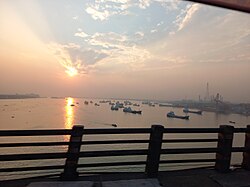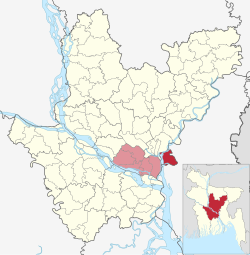Gazaria Upazila (Bengali: গজারিয়া) is one of the six upazilas of Munshiganj District in the Division of Dhaka, Bangladesh.[4] It is located on the Meghna river delta, 28 kilometres (17 mi) from the capital city of Dhaka.
Gazaria
গজারিয়া | |
|---|---|
 Meghna Bridge near Gazaria | |
 | |
| Coordinates: 23°32′30″N 90°36′30″E / 23.5417°N 90.6083°E | |
| Country | |
| Division | Dhaka |
| District | Munshiganj |
| Area | |
• Total | 131.00 km2 (50.58 sq mi) |
| Population | |
• Total | 185,259 |
| • Density | 1,400/km2 (3,700/sq mi) |
| Time zone | UTC+6 (BST) |
| Postal code | 1510[2] |
| Area code | 06922[3] |
| Website | gajaria |
History
editThis article needs additional citations for verification. (May 2016) |
Gazaria is mainly composed of alluvial land around the Meghna river. The locality became a part of Tippara (now Cumilla) Thana under the Assam District during British rule. Gazaria became the part of Munshiganj Thana in 1946 and the independent Gazaria Thana was established in 1954.
The Pakistan government established the Dhaka-Chattogram Highway through the locality. Gazaria Thana was turned into an upazila in 1983.
War of Independence
editIn May 1971, the Pakistani army entered Gazaria by river. A raid on the village of Goshairchar on 9 May killed more than four hundred people. The army proceeded to Bhaberchar where they also killed eleven sheltering in a ditch. Other villages in the area were attacked in the same raid.
Bangladeshi soldiers from Gazaria fought at Bhabercha, Baluakandi and Baushia under the leadership of Rafiqul Islam and interrupted communication along the highway by destroying the bridge at Bhaterchar in August 1971, obstructing the advancement of the Pakistani army.
In 2011 the Local Government constructed a memorial at Goshairchar, Gazaria.
Geography
editGazaria Upazila is located at 23°32′30″N 90°36′30″E / 23.5417°N 90.6083°E, covering a total area of 130.92 km2. It is the Meghna River delta, which separates it from the district headquarters of Munshiganj. Two bridges connect it with the mainland: the Meghna Bridge in the west, and the Meghna-Gomoti Bridge in the east. The Kajali river flows through the district.[citation needed]
Demographics
editAccording to the 2011 Census of Bangladesh, Gazaria Upazila had 34,760 households and a population of 157,988. Out of this population, 34,949 inhabitants (22.12%) were under 10 years of age. Gazaria had a literacy rate (age 7 and over) of 57.19%, compared to the national average of 51.8%, and a sex ratio of 1006 females per 1000 males. 6,559 (4.15%) lived in urban areas.[6][7]
According to the 1991 Bangladesh census, Gazaria had a population of 128,368.
Administration
editGazaria Upazila is divided into eight union councils: Baluakandi, Baushia, Gajaria, Guagachia, Hosendee, Imampur, Tengarchar, and Vaberchar. The union parishads are subdivided into 114 mauzas and 133 villages.[8]
Literacy rate
editIn 2001 Gazaria had a literacy rate of 32.7% (counting people over the age of 7), compared to national figures of 32.4%.[9]
References
edit- ^ National Report (PDF). Population and Housing Census 2022. Vol. 1. Dhaka: Bangladesh Bureau of Statistics. November 2023. p. 398. ISBN 978-9844752016.
- ^ "Bangladesh Postal Code". Dhaka: Bangladesh Postal Department under the Department of Posts and Telecommunications of the Ministry of Posts, Telecommunications and Information Technology of the People's Republic of Bangladesh. 20 October 2024.
- ^ "Bangladesh Area Code". Stockholm, Sweden: Rebtel.com. 18 October 2024.
- ^ Rahman, AKM Habibur (2012). "Gazaria Upazila". In Islam, Sirajul; Jamal, Ahmed A. (eds.). Banglapedia: National Encyclopedia of Bangladesh (Second ed.). Asiatic Society of Bangladesh.
- ^ Population and Housing Census 2022 - District Report: Munshiganj (PDF). District Series. Dhaka: Bangladesh Bureau of Statistics. June 2024. ISBN 978-984-475-282-5.
- ^ "Bangladesh Population and Housing Census 2011 Zila Report – Munshiganj" (PDF). bbs.gov.bd. Bangladesh Bureau of Statistics.
- ^ "Community Tables: Munshiganj district" (PDF). bbs.gov.bd. Bangladesh Bureau of Statistics. 2011.
- ^ "District Statistics 2011: Munshiganj" (PDF). Bangladesh Bureau of Statistics. Retrieved 14 July 2014.
- ^ "Population Census Wing, BBS". Archived from the original on 2005-03-27. Retrieved November 10, 2006.